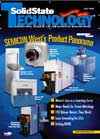Table of Contents
Solid State Technology
Year 2003
Issue 7
 | DEPARTMENTS
Editorial
What's next? Pervasive intelligence?
Looking back, it's easy to recall that the huge "killer" applications for electronics that led to booms in the semiconductor industry were obvious. But in the early phases, it wasn't always that easy to predict that something would turn out to be a giant winner, like, in their time, transistor radios, calculators, color TVs, VCRs, and PCs.
World News
World News
Tech News
Technology News
Feol
Multilayer resist strategies
IC manufacturers face a number of economic pressures today, not the least of which is the high cost of transitioning to tools with shorter wavelengths or higher numerical apertures. This, in turn, challenges lithographers to maximize the life of present-generation tool sets.
Interconnect
Learning from recording head manufacturing about 3-D structural process control
The industry's trend to more device structures stacked on a die, increasingly including copper interconnects and low-k dielectrics, has forced the need to develop techniques that will let us see, measure, and ultimately control these structures. new structures.
New Products
Product Panorama
Perspectives
MEMS: One-of-a-kind challenges
Solid State Technology asked industry experts for their views on the unique challenges and opportunities in the MEMS-manufacturing arena.
|
|
FEATURES
Fab Management
Using learning curve theory to redefine Moore's Law
The impact of the semiconductor integrated circuit (IC) on modern life is hard to overestimate. From computers to communication, entertainment to education, the growth of electronics technology, fueled by advances in semiconductor chips, has been phenomenal.
Metrology
A critical analysis of techniques and future CD metrology needs
Control of feature dimension is so crucial to producing ICs that the metrology step is routinely referred to as a critical dimension (CD) measurement. Manufacturing ICs with faster clock speeds requires controlled transistor gate length variation as well as interconnect structure control. So, a CD measurement can be either a linewidth or a contact-via diameter or area.
Metrology
Maximizing process latitude by specifying via/contact layer reticles
This technique detected slightly undersized contacts directly corresponding to the coordinates of the repeating wafer defects, yet these same defects had not been detected by standard reticle inspection.
Resists
ArF and F2 lithography using bilayer resists
To achieve production at sub-100nm device targets, a thinner (<2000Å) imaging layer with improved etch resistance will be required to obtain robust manufacturing processes.
Thermal Processing
Junction scaling using lasers for thermal annealing
As semiconductor manufacturing continues to follow Moore's Law, junction annealing has been forced to evolve to ever-shorter times and higher temperatures to limit transient enhanced diffusion and improve dopant activation levels.
Mems
Using an HDP reactor to make barrier stack etches for MEMS devices
Similar to those processes used by the large integrated device makers for high-volume CMOS products, the basic sequence of thin film deposition, photolithography, and etch is repeated many times to make a finished MEMS device.
Deposition
Diffusion barrier material for Cu metallization using ALD-WNxCy
At the 2002 IITC Conference, the authors reported a novel ALD-WNxCy process developed at ASM Microchemistry Ltd. for a diffusion barrier application using the Pulsar 2000 and 3000 ALCVD reactors [3].
Materials
Moving from today's SOI to advanced substrate engineering
As IC technology continues to grow, there will be an increasing need for engineered substrates tailored for specific applications.
Ion Implantation
Narrow n+/p+ isolation in retrograde well implants
As device dimensions continue to shrink, the lateral offset of the dopant due to shadowing effects becomes increasingly large relative to the size of the implanted well. This leads to variations in device and isolation performance as a function of feature orientation on the wafer.
Waste Effluent Treatment
Analyzing available alternatives for point-of-use abatement
Point-of-use (POU) abatement is often used to minimize the overall environmental, health and safety impacts of various semiconductor processes, including deposition and etch.
Wafer Cleaning
Evaluating different approaches to critical HF-last cleaning
From a comparison of a conventional multitank, HF-last process to a single-step, in situ HF-last process, we have found that dilute chemicals and in situ HF and drying are key factors in cleaning wafers with submicron critical dimensions.
| |
SEMICON-WESTWORLD
Innovative Products For
Innovative products for wafer processing focus on smaller features, fewer defects, and COO
Visitors to the wafer-processing segment of Semicon West in San Francisco's Moscone Center will see a wide array of innovative products, allowing smaller features to be made with higher throughput and fewer defects.
Maximize Your Time On Th
Maximize your time on the exhibit floor with a good final manufacturing plan
Seasoned attendees of Semicon shows, particularly Semicon West with its split venue, know that a good plan of attack can increase your effectiveness on the exhibit floor.
| |
|